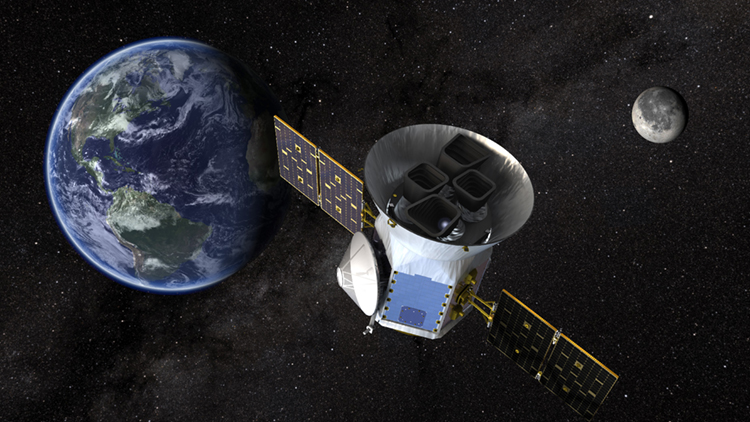Last week, on April 18, a next-generation planet-hunting satellite was carried into orbit. The Transiting Exoplanet Survey Satellite (TESS) was launched from Cape Canaveral in Florida. Designed by the United States National Aeronautics and Space Administration (NASA), TESS will search for exoplanets (planets orbiting stars beyond our solar system).
TESS was carried into space by a SpaceX Falcon 9 rocket. After boosting the satellite into orbit, the first stage of the rocket landed on a crewless barge in the Atlantic Ocean and will be used again. When TESS reaches its desired orbit, it will undergo testing and calibration before it begins the search for exoplanets.
TESS will replace NASA’s planet-hunting satellite Kepler, which is almost out of fuel. Launched in 2009, Kepler has discovered thousands of exoplanets. Like Kepler, TESS will use the transit method to search for exoplanets. As an exoplanet passes in front of its parent star, it blocks out a tiny portion of the star’s light (an event called a transit). TESS can detect these telltale dips in the intensity of the light.

Although TESS will use the transit method, it is far from a Kepler clone. TESS will study brighter stars than Kepler did. This means that all of TESS’s targets will be at most 200 light-years from Earth. Because TESS is limited to closer, brighter stars, it will be easier for astronomers to confirm the finds and perform follow-up studies. TESS will also be able to observe the whole sky, as opposed to Kepler’s ability to only study small sections of sky at a time. TESS will also focus its search on finding Earth-sized exoplanets, especially those that orbit their star in the habitable zone, the range of an orbit where liquid water may be present on a planet’s surface. Liquid water is necessary for all life on Earth.
One of the tools astronomers will use to follow up on TESS’s discoveries will be NASA’s James Webb Space Telescope (JWST). The JWST is the most powerful space telescope ever built. Due to launch in 2020, it will be able to search for possible signs of life on the planets that TESS finds. Another observatory will be the Characterizing Exoplanets Satellite (CHEOPS). Designed by the European Space Agency, CHEOPS will launch at the end of 2018. Rather than being strictly a planet hunter, CHEOPS will focus on studying the makeup of smaller exoplanets that have already been discovered. It will likely be able to better define some of the exoplanets TESS discovers.
Astronomers have long hoped to learn whether—and, if so, where—other life exists in the universe. With TESS, JWST, and CHEOPS, they will be able to pinpoint nearby exoplanets with potential for life. But it will likely take even more advanced telescopes to determine if the planets actually teem with living things, like Earth.
Untitled Document
Can't view the linked articles? Subscribe to World Book Online

World Book Online delivers a progressive sequence of core databases supported by supplemental
tools, such as language translation, graphic organizers, and unique Webquests. Moving from
Early World of Learning to World Book Advanced, World Book Online aligns end-users with their
appropriate learning levels. Each stand-alone site provides additional features to support the
needs of users’ specific capabilities.
The World Book Difference
World Book combines cutting-edge technology with traditional editorial excellence to produce
authoritative, trustworthy, and unbiased content. The digital content is updated in real time and
carefully curated for each learning level. Accessible 24/7, the content is available on a variety of devices.
World Book Online combines 21st-century instructional techniques with timely information.
By breaking down complex topics and using easily understandable text, World Book Online helps to
build fluency and increase comprehension. Featuring single sign-on capability, these sites are paired
with highly visual content to engage even the most reluctant reader. Our collection of resources kindles
a lifelong learning experience for every user. This adherence to clarity, currency, and accuracy makes
World Book’s digital offerings an information hub for the classroom, library, and beyond.
Image 1: At Cape Canaveral Air Force Station in Florida, the SpaceX Falcon 9 rocket carrying NASA’s Transiting Exoplanet Survey Satellite (TESS) lifts off on April 18, 2018. Credit: SpaceX
Image 2: NASA’s Transiting Exoplanet Survey Satellite (TESS), shown here in a conceptual illustration, will identify exoplanets orbiting stars beyond our solar system. Credit: NASA Goddard Space Flight Center